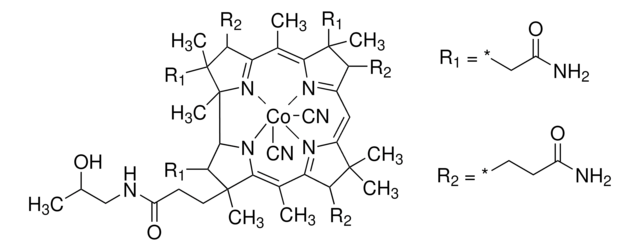V2876
Vitamin B12
≥98%
Synonym(s):
α-(5,6-Dimethylbenzimidazolyl)cyanocobamide, CN-Cbl, Cyanocob(III)alamin, Cyanocobalamin
About This Item
Recommended Products
Quality Level
Assay
≥98%
form
powder
technique(s)
HPLC: suitable
color
red to brown
storage temp.
2-8°C
SMILES string
C/C(C1=N[C@]([C@]([C@H](CC(N)=O)[C@@]/2(C)CCC(NC[C@@H](OP([O-])(O[C@H]3[C@@H](O)[C@@H](N4C=[N]5C6=C4C=C(C)C(C)=C6)O[C@@H]3CO)=O)C)=O)([H])N([Co+]5C#N)C2=C(C)/C([C@@H](CCC(N)=O)C/7(C)C)=NC7=C/8)(C)[C@@](C)(CC(N)=O)[C@@H]1CCC(N)=O)=C9N=C8[C@@H](CCC(N)=O)[C@
InChI
1S/C62H90N13O14P.CN.Co/c1-29-20-39-40(21-30(29)2)75(28-70-39)57-52(84)53(41(27-76)87-57)89-90(85,86)88-31(3)26-69-49(83)18-19-59(8)37(22-46(66)80)56-62(11)61(10,25-48(68)82)36(14-17-45(65)79)51(74-62)33(5)55-60(9,24-47(67)81)34(12-15-43(63)77)38(71-55)23-42-58(6,7)35(13-16-44(64)78)50(72-42)32(4)54(59)73-56;1-2;/h20-21,23,28,31,34-37,41,52-53,56-57,76,84H,12-19,22,24-27H2,1-11H3,(H15,63,64,65,66,67,68,69,71,72,73,74,77,78,79,80,81,82,83,85,86);;/q;;+2/p-2/t31-,34-,35-,36-,37+,41-,52-,53-,56-,57?,59-,60+,61+,62+;;/m1../s1
InChI key
RMRCNWBMXRMIRW-QJRSUKKJSA-L
Looking for similar products? Visit Product Comparison Guide
Application
- as a constituent in vitamin mix solution in in vitro gut simulator
- as a standard in size exclusion inductively coupled plasma mass spectroscopy (SEC-ICP-MS)
- as a constituent of simulated plasma protein mixture for Raman spectra analysis
- in surface plasmon resonance (SPR) analysis
- as a medium supplement in neonatal rat ventricular myocytes (NRVM)
Biochem/physiol Actions
Storage Class Code
11 - Combustible Solids
WGK
WGK 1
Flash Point(F)
Not applicable
Flash Point(C)
Not applicable
Personal Protective Equipment
Certificates of Analysis (COA)
Search for Certificates of Analysis (COA) by entering the products Lot/Batch Number. Lot and Batch Numbers can be found on a product’s label following the words ‘Lot’ or ‘Batch’.
Already Own This Product?
Find documentation for the products that you have recently purchased in the Document Library.
Customers Also Viewed
Our team of scientists has experience in all areas of research including Life Science, Material Science, Chemical Synthesis, Chromatography, Analytical and many others.
Contact Technical Service






